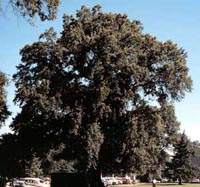Resource Library
Plant of the Week: Willow Oak
The University of Arkansas System Division of Agriculture does not promote, support or recommend plants featured in "Plant of the Week." Please consult your local Extension office for plants suitable for your region.
Plant of the Week
Willow Oak
Latin: Quercus phellos

Size matters. If there is room in the landscape, one should always plant trees that
will reward one with grand stature and become a lasting monument to the person who
had the forethought to plant them. One of the grandest of these big trees is our native
willow oak.
Several trees share the title as recordholder for the species, with the closest in
Memphis, Tenn., at 123 feet tall with a spread of 100 feet.
The willow oak is native to bottomland forests across a broad swath of the southeastern
U.S. from southwestern Oklahoma, across the lowlands of Arkansas to Florida and north
as far as southern New York. It is unlike most oaks in that the leaves are willow-like
in shape. The leaves are about 3- to 4 inches long and about three-quarters of an
inch across and completely lack all evidence of lobes. The leaf is tipped with a single
bristle indicating it is a member of the red oak group. For such a large tree, the
acorns are one of the smallest of the genus and usually measure about one-half inch
long and wide.
By naming things we are supposed to -- at least in theory -- reduce confusion, but
with plants, name confusion is one of the things you just have to deal with. The name
willow oak fits this tree nicely because the leaf looks more like that of a willow
than it does most oaks. But the leaf also looks like a fountain pen, so south of the
Arkansas River the tree is often called the "pen oak." This creates real confusion
because the pin oak, Quercus palustris, is also a common landscape tree.
The species name "phellos" is Latin for cork -- apparently because old trees have
a thick corky bark. However, it should not be confused with the real cork oak, Q.
suber, which is an evergreen oak from southern Europe that produces the cork of commerce.
People often ask for fast-growing shade trees, but that trait should be way down
on the list of criteria used when selecting a shade tree. Willow oaks are in the medium
growth rate group with trees such as pin oaks, red maples, sweet gums and green ash.
It averages about two feet of growth a year once established. Thirty-year-old trees
here in Fayetteville on upland sites are about 50 feet tall with a trunk diameter
of about 15 inches.
As a landscape tree, willow oaks are best suited to larger sites, public parks or
along roadways. It is the grandest tree in many of Little Rock’s public parks and
is used throughout the city as a street tree. Willow oak leaves are yellow in the
fall and quickly dislodge themselves from the tree, not hanging on over winter like
the pin oak. The leaves make great landscape mulch and are not as apt to smother the
lawn as other oaks if one is tardy about raking the leaves in the fall.
Willow oaks transplant readily and will grow in a wide array of soils. However, they
grow faster and to a larger size in bottomland sites or areas with reasonably fertile
conditions. Once established they tolerate drought well.
By: Gerald Klingaman, retired
Extension Horticulturist - Ornamentals
Extension News - January 21, 2000
The University of Arkansas System Division of Agriculture does not maintain lists of retail outlets where these plants can be purchased. Please check your local nursery or other retail outlets to ask about the availability of these plants for your growing area.